Archaeologists in Spain have uncovered the first known Neanderthal bone spear point (in the region), challenging what we thought we knew about these ancient humans’ hunting and crafting abilities.
In a groundbreaking discovery at the Abric Romaní rock shelter, near Barcelona, Spain, researchers have found the only known example of a Neanderthal spearhead made from a horse bone. This 50,000-year-old artifact is now forcing experts to rethink the technological capabilities of Neanderthals and their resourcefulness when it came to crafting hunting tools.
What Makes This Discovery So Important?
Previously, Neanderthals were thought to primarily rely on stone tools for hunting. However, this bone spearhead, found by archaeologists from the Catalan Institute of Human Paleoecology and Social Evolution (IPHES), reveals that these ancient humans had a more flexible approach to tool-making than we initially believed. The spearhead is an extraordinary find due to the microscopic impact marks and fractures at its tip, indicating it was intentionally shaped for hunting purposes.
In addition to its unique composition, the spearhead also bears traces that suggest it was attached to a wooden shaft, further proving its use as a hunting weapon. Such a discovery broadens our understanding of how Neanderthals hunted and lived during the Middle Palaeolithic period.
The Significance of Neanderthal Bone Technology
Bone tools were not exclusive to Neanderthals. Hominins have been crafting tools from bones as far back as the Lower Palaeolithic period, with evidence of such technologies dating to around 2 million years ago in South Africa and Tanzania. In Europe, bone tools have been found in sites inhabited by both Neanderthals and their pre-Neanderthal ancestors, such as Boxgrove in England and Gran Dolina in Spain.
However, most of these bone tools were simple implements used for scraping hides or digging. The discovery of a spearhead, a tool used specifically for hunting, marks a significant shift in our understanding of Neanderthal innovation. It challenges the previous assumption that Neanderthals turned to bone only when stone was unavailable. In fact, the abundance of stone tools at the Abric Romaní site contradicts this theory, indicating that Neanderthals were intentional in their choice of bone as a material for their tools.
What This Means for Our Understanding of Neanderthals
The Abric Romaní spearhead offers new insights into the hunting strategies and technical skills of Neanderthals. This discovery proves that Neanderthals were not just passive users of their environment but active innovators, capable of adapting their technology to fit their needs. It adds to the growing body of evidence that Neanderthals were far more advanced than we previously thought, especially when it comes to their craftsmanship and use of materials.
According to the researchers, the spearhead shows how Neanderthals used composite bone tools in their hunting practices, reflecting their adaptability and technological diversity. This newfound knowledge opens the door for further exploration into early bone technology, potentially revealing even more about how these ancient humans survived in challenging environments.
The discovery of this 50,000-year-old bone spearhead is a game-changer in the field of archaeology. It not only reshapes our understanding of Neanderthal technology but also highlights the complexity of their hunting techniques. As more research is conducted at sites like Abric Romaní, we can expect to uncover even more about these fascinating ancestors of ours.











